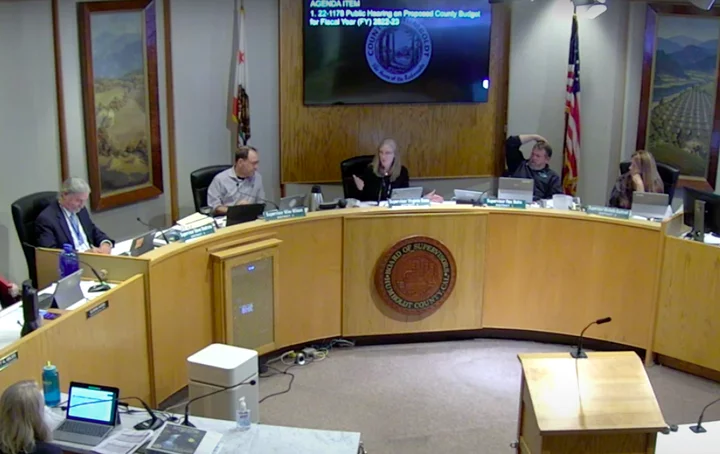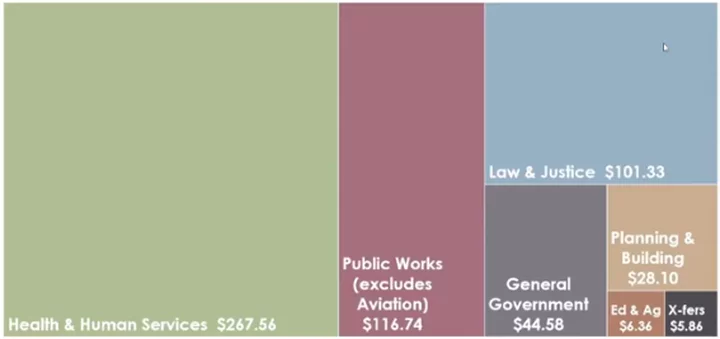Screenshot of Monday’s Humboldt County Board of Supervisors meeting.
###
Humboldt County is still trying to get its finances in order.
During a special meeting on Monday afternoon, the Humboldt County Board of Supervisors embarked on a grueling discussion surrounding the county budget proposal for Fiscal Year 2022-23. Rather than focusing on various improvements to county infrastructure as in years past, this year’s budget aims to address ongoing budgetary gaps.
“Last year’s funding was utilized much more effectively for infrastructure and service enhancements,” County Administrative Officer Elishia Hayes explained. “This year, the funding is very much going to help to close budgetary gaps and to help us with the budgetary challenges that we’re having. [This budget proposal] hasn’t gone through the same sort of community input and evaluation process that we followed last year because, frankly speaking, we need these dollars to just continue with services this year.”
The county’s annual budget is normally settled by the end of June. This year, however, budgetary challenges stemming from a backlog of delinquent financial reports forced the Board of Supervisors to postpone the adoption of the final budget to give staff additional time to complete the audit for Fiscal Year 2019-20 and obtain more reliable estimates for the county’s fund balances. The board adopted a “recommended” budget at the end of June to serve as a placeholder for the final budget, which is scheduled for adoption at the end of this month.
“It has been an interesting and unique year for [our] budget,” said Tabatha Miller, assistant county administrative officer and chief financial officer.
On top of the aforementioned budget challenges, the county experienced a significant loss in revenue following the board’s decision to slash cannabis cultivation taxes earlier this year. The board also signed off on “some pretty significant increases” to employee salaries and benefits, which was done in hopes of improving recruitment and retention, Miller explained.
“[The county’s] total budget is $570.5 million, so it’s a pretty significant amount,” she said. “The graph here kind of breaks it down by size as far as where those dollars are being budgeted.”
Screenshot
The bulk of the budget discussion focused on additional funding requests. Item by item, Miller outlined dozens of requests for additional funding from various county departments and organizations. In most cases, the money would be sourced from the county’s General Fund or remaining ARPA – American Rescue Plan Act – funds. (You can find a breakdown of the funding requests at this link.)
One of the most notable items on the list was a request for $3.5 million from the Public Works Department to reduce the negative fund balance in the county’s roads fund.
“We know that we don’t have sufficient revenues to support our roads in the county and … we’re not even providing the roads at a level of quality that the citizens would like,” Miller said. “We have a significant deficit fund balance in that particular fund and there isn’t really any way to get around [it] other than [allocating] ARPA funds, which is what we’re proposing here, or pulling money out of the General Fund.”
Where did all the money go? Public Works Director Tom Mattson said the fund was drained by storm damage repairs back in 2017 and 2019.
“We have to do those projects for reimbursements and sometimes those reimbursements can be 10, 15 or 20 years down the line,” Mattson explained. “If I don’t do the projects within the timeline, then we’re not going to do the projects because we won’t get the funding. These are multimillion-dollar projects. …Now our equipment and our material costs have jumped 30% due to COVID and issues with the supply chain.”
Board Chair and Fourth District Supervisor Virginia Bass asked if the Public Works Department was further impacted by “concerns with the auditor’s office and not being reimbursed for certain things.” Bass, of course, is referring to the previous Auditor-Controller’s failure to submit important financial reports to the state in a timely fashion, a move that put the county at risk of missing out on grants and reimbursements from the state and federal government.
“We lost out on well over [$750,000],” Mattson said. “Now that we finally have one of our audits done, [we] can start putting our indirect cost plans back together and that will allow us to start charging our overhead back to our all of our state and federal projects.”
“That $750,000 is gone gone?” Bass asked.
“That’s gone,” Mattson said. “We cannot go back after the project is closed.”
First District Supervisor Rex Bohn suggested staff seek additional funding from Senate Bill 1, the Road Repair and Accountability Act of 2017, to offset some of the costs.
“The state has an excess of SB-1 monies … and they’re doing a good job but they’re having a hard time spending all their money,” he said. “We should ask for some one-time or maybe a few years of some extended spending for our rural areas and our roads. … We can pertain it to feeder roads or roads that are within a mile of state highway or something like that because I’ve got plenty of roads that are failing within a mile of a state highway.”
Hayes suggested the board forward the inquiry to North Coast representatives Assemblymember Jim Wood and state Senator Mike McGuire.
The board also discussed several other funding requests, including a $735,874 request for office renovations for the Auditor-Controller’s Office, a $15,000 request for travel and mileage reimbursement from Fifth District Supervisor Steve Madrone, a $5,500 request to remove the defunct tsunami siren pole at the Orick Volunteer Fire Department, an additional $59,000 to fund the county’s Laura’s Law pilot program, as well as three individual requests totaling $850,000 from the Sheriff’s Office for building maintenance.
About halfway through the board’s review, Second District Supervisor Michelle Bushnell asked whether the county had enough money to fund the list of recommended funding requests.
“You have the money,” Miller said. “Anything that you see here on this list that says ‘general fund contribution’ means that it’s coming out of your general fund, which means that you are dipping into your fund balance. So, you have funding there … just remember you’re digging into your savings and borrowing from money you can’t spend in the future.”
After about four hours of discussion and a few recommendations to staff, the board agreed to return to the subject later this month for final review. The final budget is scheduled for adoption on Sept. 27.
A recording of the board’s discussion can be found here.
###
Document: Additional General Fund Budget Appropriation Requests for FY 2022-23


CLICK TO MANAGE